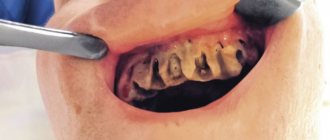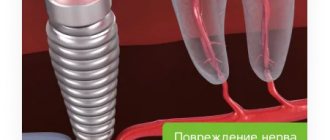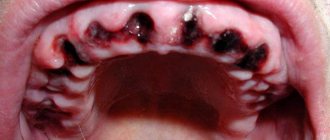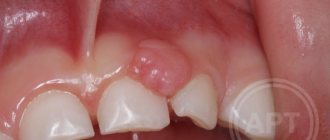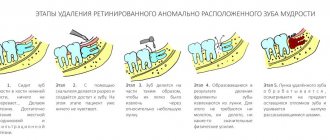After the end of exposure to anesthetic substances, the pain syndrome returns to the patient who has survived tooth extraction. Pain can be a natural reaction of tissues to tooth extraction surgery, or a symptom of complications. To avoid a negative scenario, you should carefully prepare for the operation. Even successful treatment leaves the patient with many questions.
Content:
- When white plaque is the norm
- When white plaque is a harbinger of disease
- Why do complications occur after tooth extraction?
- How to recognize the problem
- Diagnostic measures
- Treatment of alveolitis
After tooth extraction, it is important to monitor the condition of the mucous membrane.
Very often a white coating appears in the extraction area. It frightens patients because it seems something strange to them, and to some it resembles an accumulation of purulent masses. It should be noted that white plaque in the socket after tooth extraction can be either normal or a complication. In the first case we are talking about natural regeneration, in the second - about alveolitis.
Causes
After a tooth has been removed, alveolitis of the socket often occurs. Certain factors may contribute to this:
- the blood clot, which prevents infection from entering the wound, has been destroyed;
- bone fragments, stone, plaque got into the hole during the removal procedure;
- the specialist did not clean the hole very well from granulations and granules;
- sterility was compromised;
- the removal was very traumatic;
- the patient did not follow all the doctor’s instructions;
- The patient's body is exhausted, immunity is quite low.
When a regular tooth or wisdom tooth has been removed, you should not rinse your mouth too vigorously, as there is a risk that the blood clot located in the socket will be washed out. The result is that microbes get inside and provoke an inflammatory process.
When white plaque is the norm
Nature intended it so that damaged tissues should be protected from the penetration of infectious agents. This is why, after a tooth is removed, a clot and white plaque forms in the socket. The latter is nothing more than fibrin, a protein needed for blood clotting. It protects the wound surface from infection and does not allow the inflammatory process to spread.
At first, the white film seems very thin, but gradually it turns into bone tissue. Some even mistake plaque for food debris and try to remove it with their tongue or using foreign objects. Under no circumstances should this be done. If the wound heals according to plan, there are no severe pain symptoms, there is no need to worry or touch it. This can lead to complications.
So, fibrin in the form of a whitish coating is needed to:
- the wound healed quickly;
- no infection penetrated into the socket;
- soft tissues were not inflamed.
If the patient has questions regarding the white clot on the surface of the damaged gum, he should consult with his dentist. You don't need to do anything yourself.
General overview
Extraction of an element of the dentition is a process during which the gums receive extensive trauma. Tooth extraction leads to rupture of nerves and ligaments, as well as destruction of small blood vessels, resulting in local bleeding. This process is natural in nature and is a protective mechanism - the blood limits the possibility of pathogenic bacteria entering the socket that can cause infection. During the folding process, a reliable barrier is formed that protects the internal tissues until complete recovery. The formation of white plaque is a normal phenomenon, since it is not a purulent structure, but an element necessary for the regeneration of the jaw region.
When undergoing tooth extraction surgery, you should prepare in advance for possible consequences, the list of which includes:
- Moderate bleeding that persists for several hours;
- Formation of a dense blood clot over the socket;
- Unpleasant odor that occurs 10-12 hours after the procedure;
- Formation of a white coating on the surface of the blood clot;
- Painful manifestations in the area of intervention;
- Increased body temperature.
These symptoms are not pathological in nature and are a normal reaction of the body to radical intervention.
When white plaque is a harbinger of disease
It also happens that a whitish coating indicates the development of alveolitis after tooth extraction. This means that the tooth socket has become infected. In this condition, the patient is concerned about:
- severe pain in the area of the removed unit;
- increased body temperature;
- weakness, decreased performance;
- enlargement of the submandibular lymph nodes;
- headache;
- unpleasant putrid odor from the mouth and the same taste in the mouth.
If you experience these symptoms, you should make an appointment at the dental clinic as soon as possible.
Prevention of alveolitis at SM-Dentistry
If the operation is not an emergency, then dentists first treat caries and other inflammatory diseases in the oral cavity, which can become a source of infection.
After the operation, you will receive detailed recommendations for caring for the socket so that the blood clot forms correctly and does not break down prematurely. To do this, you must follow a diet (do not eat hard or hot foods), do not use intensive rinsing and cleaning in the area of the injured hole, and use antiseptic and painkillers.
Sign up for a consultation with a dental surgeon by calling 24/7 in Moscow +7 (495) 777-48-06.
Dentist consultation Treatment of caries
Why do complications occur after tooth extraction?
The most common reason for the development of complications is the patient’s failure to comply with medical prescriptions. Normally, the hole should heal within a few days. She shouldn't be sick for a long time. As a result of the fact that the blood clot closes it, it is reliably protected from viruses and food debris.
It happens that a person actively rinses the wound or constantly touches it with his tongue, fingers, and tries to remove the light coating. Then the clot displaces or does not form completely, the tissue becomes infected and alveolitis develops.
Untreated neighboring teeth can also lead to disease (which is why all carious “cavities” need to be treated before removal), and failure to comply with the rules of oral hygiene. If you properly prepare for extraction and follow all the doctor’s instructions, the risk of developing alveolitis after removal will be minimal.
How to behave after wisdom tooth extraction
Removing so-called wisdom teeth is a particularly difficult process; the wound has to be sutured. Sutures on the gum oblige you to be even more attentive to the wound and strictly adhere to the doctor’s recommendations.
There are stitches on the wound
Rules of conduct after wisdom tooth extraction:
- Do not open your mouth too wide - there is a risk of seams coming apart;
- if the doctor prescribed antibiotics, take them strictly according to the schedule;
- the temperature has increased - take an antipyretic;
- for acute pain, you need to take painkillers; the pain can last a week or a little more.
Tablets for fever and pain
If the pain is severe and lasts more than 10 days, rush to see a doctor. The risk of complications cannot be excluded, and this will require special therapy and dental procedures.
How to recognize the problem
How to understand that white plaque signals a problem?
If the gums heal well, then within 2-3 days after surgery the pain becomes very weak and barely noticeable. The wound closes with a dense clot and practically does not bother the person. With the development of alveolitis on days 3-5, the pain, on the contrary, intensifies. It's pulsating. It can become unbearable. Sometimes it radiates to the entire half of the face. Body temperature rises, lymph nodes enlarge, appetite decreases, salivation becomes stronger. The face may also become swollen.
In such a situation, staying at home is dangerous - inflammation can spread to the deep tissues of the jaw. You need to immediately go to the dental clinic.
Prices
| Name of service | Price, rub.) * |
| Initial consultation with a dentist-therapist | 1,500 rub. |
| Repeated consultation with a dentist-therapist | 800 rub. |
| Treatment of caries (imaging, anesthesia, isolation of the oral cavity, installation of an insulating lining and filling made of composite light-curing imported material) | from 4,350 rub. |
| Treatment of alveolitis with socket revision | 3,000 rub. |
We accept VISA, MASTERCARD, MAESTRO bank cards for payment.
Would you like us to call you back?
Treatment of alveolitis
If alveolitis occurs after tooth extraction, you need to undergo dental treatment aimed at:
- elimination of the infectious focus;
- preventing possible complications;
- maintaining the integrity of the rest of the dentition.
First, the dentist cleans the socket and rinses it. It is important to wash away all purulent masses and dead tissue from it. Antiseptics and hydrogen peroxide work well for this purpose.
To reduce painful symptoms, which deprive the patient of the opportunity to fully rest and work, analgesics are used. It is better to use them by applying applications. Compresses are changed every half hour. It is also possible to take drugs orally, that is, in the form of painkillers and anti-inflammatory tablets.
If the patient has concomitant diseases or reduced immunity, the doctor may decide to prescribe antibiotics. They quickly relieve inflammation and speed up the healing of damaged tissue.
If you seek qualified dental care in a timely manner, the prognosis for alveolitis is favorable. After 3-5 days, the symptoms begin to subside, and the person’s well-being improves. Residual socket pain may persist for another 2-3 weeks, but it does not pose a threat.
Medicines prescribed by specialists
When the patient has visited the dental center and had a professional treatment of the hole, he must start taking medications to cure the alveolitis. Drugs that have proven their effectiveness include:
- Hexicon. This is an antiseptic drug that is taken topically. You can use it to rinse, make mouth baths, and applications;
- Corsodil. An antiseptic medicine that has a bactericidal effect. It is also used to disinfect the mouth. Corsodil can be used to create applications, irrigation, rinsing;
- Stomatidin. An antiseptic that prevents infection from spreading. You can make applications with it, as well as rinse your mouth;
- Chlorhexidine. Antiseptic, which is known for its wide spectrum of action. It is used to treat the mucous membranes of the oral cavity and treat purulent wounds;
- Eludril. It has an antiseptic, anti-inflammatory, analgesic effect.
IMPORTANT! Professional dentists prescribe their own medication to each patient in accordance with the clinical picture and characteristics of the body, therefore it is not recommended to self-medicate so as not to aggravate the condition.
How to rinse your mouth after surgery
Ready-made pharmacy antiseptics and solutions made independently at home are applicable. Let's consider how to rinse your mouth after gum surgery or tooth extraction.
Your doctor may recommend not rinsing the wound on the day of surgery. Every other day, you can make oral baths with decoctions of chamomile, sage, or solutions of furatsilin, 0.05% chlorhexidine.
There are quite a few such drugs, and your doctor will give specific recommendations on what to rinse your mouth after gum or tooth removal. The choice of a suitable drug depends on the condition of the hole, the complexity of removal, the age of the patient, whether he has allergies or sensitivity to some components of the products.
Carefully! It is not recommended to use ethyl alcohol, hydrogen peroxide solution, brilliant green or iodine for rinsing. They can cause pain, burn the mucous membrane and lead to the detachment of a fresh clot.



